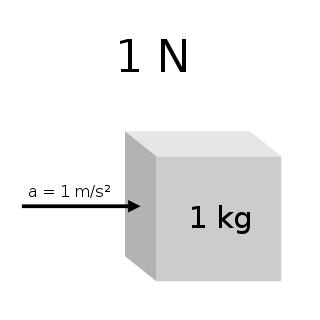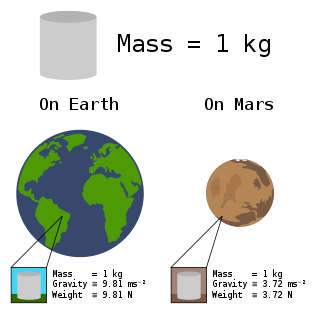Related Research Articles

The inch is a unit of length in the British imperial and the United States customary systems of measurement. It is equal to 1/36 yard or 1/12 of a foot. Derived from the Roman uncia ("twelfth"), the word inch is also sometimes used to translate similar units in other measurement systems, usually understood as deriving from the width of the human thumb.

Measurement is the quantification of attributes of an object or event, which can be used to compare with other objects or events. In other words, measurement is a process of determining how large or small a physical quantity is as compared to a basic reference quantity of the same kind. The scope and application of measurement are dependent on the context and discipline. In natural sciences and engineering, measurements do not apply to nominal properties of objects or events, which is consistent with the guidelines of the International vocabulary of metrology published by the International Bureau of Weights and Measures. However, in other fields such as statistics as well as the social and behavioural sciences, measurements can have multiple levels, which would include nominal, ordinal, interval and ratio scales.
The International System of Units, internationally known by the abbreviation SI, is the modern form of the metric system and the world's most widely used system of measurement. Established and maintained by the General Conference on Weights and Measures (CGPM), it is the only system of measurement with an official status in nearly every country in the world, employed in science, technology, industry, and everyday commerce.

United States customary units form a system of measurement units commonly used in the United States and most U.S. territories, since being standardized and adopted in 1832. The United States customary system developed from English units that were in use in the British Empire before the U.S. became an independent country. The United Kingdom's system of measures was overhauled in 1824 to create the imperial system, which was officially adopted in 1826, changing the definitions of some of its units. Consequently, while many U.S. units are essentially similar to their imperial counterparts, there are significant differences between the systems.
In science and engineering, the weight of an object is the force acting on the object due to acceleration or gravity.

The pascal is the unit of pressure in the International System of Units (SI), and is also used to quantify internal pressure, stress, Young's modulus, and ultimate tensile strength. The unit, named after Blaise Pascal, is defined as one newton per square metre and is equivalent to 10 barye (Ba) in the CGS system. The unit of measurement called standard atmosphere (atm) is defined as 101,325 Pa.

The newton is the unit of force in the International System of Units (SI). It is defined as 1 kg⋅m/s2, the force which gives a mass of 1 kilogram an acceleration of 1 metre per second per second. It is named after Isaac Newton in recognition of his work on classical mechanics, specifically Newton's second law of motion.
The pound of force or pound-force is a unit of force used in some systems of measurement, including English Engineering units and the foot–pound–second system.
The ounce is any of several different units of mass, weight or volume and is derived almost unchanged from the uncia, an Ancient Roman unit of measurement.

The newton-metre is the unit of torque in the International System of Units (SI). One newton-metre is equal to the torque resulting from a force of one newton applied perpendicularly to the end of a moment arm that is one metre long. The nonstandard notation Nm occurs in some fields.
The kilogram-force, or kilopond, is a non-standard gravitational metric unit of force. It does not comply with the International System of Units (SI) and is deprecated for most uses. The kilogram-force is equal to the magnitude of the force exerted on one kilogram of mass in a 9.80665 m/s2 gravitational field. That is, it is the weight of a kilogram under standard gravity. Therefore, one kilogram-force is by definition equal to 9.80665 N. Similarly, a gram-force is 9.80665 mN, and a milligram-force is 9.80665 μN.
The standard atmosphere is a unit of pressure defined as 101325 Pa. It is sometimes used as a reference pressure or standard pressure. It is approximately equal to Earth's average atmospheric pressure at sea level.
The slug is a derived unit of mass in a weight-based system of measures, most notably within the British Imperial measurement system and the United States customary measures system. Systems of measure either define mass and derive a force unit or define a base force and derive a mass unit. A slug is defined as a mass that is accelerated by 1 ft/s2 when a net force of one pound (lbf) is exerted on it.
A system of measurement is a collection of units of measurement and rules relating them to each other. Systems of measurement have historically been important, regulated and defined for the purposes of science and commerce. Systems of measurement in use include the International System of Units or SI, the British imperial system, and the United States customary system.
English units are the units of measurement used in England up to 1826, which evolved as a combination of the Anglo-Saxon and Roman systems of units. Various standards have applied to English units at different times, in different places, and for different applications.
The foot–pound–second system or FPS system is a system of units built on three fundamental units: the foot for length, the (avoirdupois) pound for either mass or force, and the second for time.

In common usage, the mass of an object is often referred to as its weight, though these are in fact different concepts and quantities. Nevertheless, one object will always weigh more than another with less mass if both are subject to the same gravity.

A unit of measurement is a definite magnitude of a quantity, defined and adopted by convention or by law, that is used as a standard for measurement of the same kind of quantity. Any other quantity of that kind can be expressed as a multiple of the unit of measurement.

A coherent system of units is a system of units of measurement used to express physical quantities that are defined in such a way that the equations relating the numerical values expressed in the units of the system have exactly the same form, including numerical factors, as the corresponding equations directly relating the quantities. It is a system in which every quantity has a unique unit, or one that does not use conversion factors.

The imperial and US customary measurement systems are both derived from an earlier English system of measurement which in turn can be traced back to Ancient Roman units of measurement, and Carolingian and Saxon units of measure.
References
- ↑ Comings, E. W. (1940). "English Engineering Units and Their Dimensions". Industrial and Engineering Chemistry. 32 (7): 984–987. doi:10.1021/ie50367a028.
- ↑ Klinkenberg, Adrian (1969). "The American Engineering System of Units and Its Dimensional Constant gc". Industrial and Engineering Chemistry. 61 (4): 53–59. doi:10.1021/ie50712a010.
- ↑ R. Zucker, O. Biblarz (2002). Fundamentals of Gas Dynamics. Hoboken, New Jersey: John Wiley & Sons, Inc. ISBN 0-471-05967-6.
- ↑ United States. National Bureau of Standards (1959). Research Highlights of the National Bureau of Standards. U.S. Department of Commerce, National Bureau of Standards. p. 13. Retrieved 31 July 2019.
- ↑ Halliday, David; Resnick, Robert (1974). Fundamentals of Physics (revised printing ed.). New York: Wiley. pp. 35, 68–69.
- ↑ Railway Construction and Operation Requirements – Structural and Electrical Clearances (PDF). London: Department of Transport. 1977. ISBN 0-11-550443-5 . Retrieved 29 March 2012.
1.2 These new sections represent the first stage of a complete revision and metrication of the 'Railway Construction and Operation Requirements for Passenger Lines and Recommendations for Goods Lines of the Minister of Transport', 1950 (Reprinted 1970). They are published separately in advance of the complete revision because of the urgent need for an up-to-date metric guide to the Department's requirements for clearances, both structural and electrical.